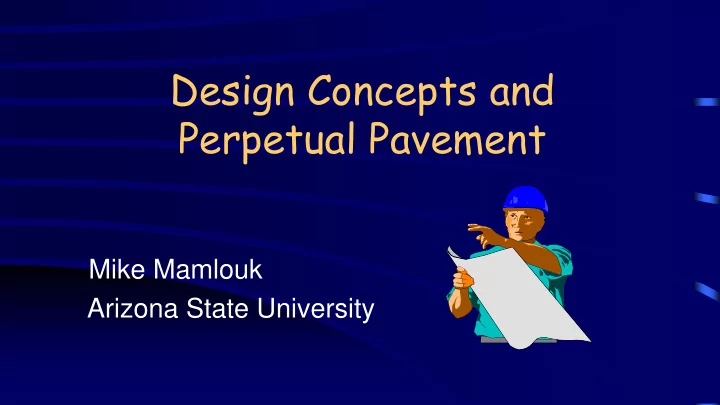

Design Concepts and Perpetual Pavement Mike Mamlouk Arizona State University
Asphalt Pavement
Why is it hard to design pavement? • Hard to estimate service life • Different load magnitudes, configurations & speeds • Multilayer system • Viscoelastic, non-linear materials • Material properties are affected by environmental conditions • Unconventional definition of failure
Distresses vs. Failure When a distress or a combination of distresses reaches a certain unacceptable level it is considered failure
Distresses Rutting in Asphalt Fatigue Cracking Pavement Thermal Cracking Roughness Shoving Bleeding/Flushing
Empirical Nature of Pavement Design Good Performance Pavement Condition Poor Age or Load Applications
Major Research Projects • AASHO Road Test • Strategic Highway Research Program (SHRP) • Mechanistic-Empirical Pavement Design Guide (AASHTOWare Pavement ME Design)
Factors Affecting Pavement Performance
Factors Affecting Pavement Performance 1. Traffic 2.Soil and pavement materials 3.Environment 4.Construction and maintenance
Traffic Traffic has a major effect on pavement performance ➢ Traffic volume ➢ Traffic load ➢ Tire pressure ➢ Rate of applying load
Severe Traffic Conditions Heavy load and high traffic volume High tire pressure Slow moving vehicles
Effect of Changing Tire Pressure
Effect of Changing Load
Effect of Tire Pressure & Loads • Changing tire pressure affects upper layers • Changing load affects deeper layers • Required quality of surface is mostly determined by tire pressure • Required pavement thickness is mostly determined by load magnitude
Factors Affecting Pavement Performance 1. Traffic 2.Soil and pavement materials 3.Environment 4.Construction and maintenance
Material quality affects performance Wheel Load Hot-mix asphalt Aggregate Base Natural soil
Factors Affecting Pavement Performance 1. Traffic 2.Soil and pavement materials 3.Environment 4.Construction and maintenance
Environmental Factors • Moisture • Temperature • Freeze and thaw • Aging
Factors Affecting Pavement Performance 1. Traffic 2.Soil and pavement materials 3.Environment 4.Construction and maintenance
Construction and maintenance • Construction and maintenance practice largely affects performance
Design Objective To determine the required layer materials and thicknesses so that the pavement would last for a certain design life before failure.
Pavement Design Approaches 1. Based on experience (ie., standard sections) 2. Based on simple strength tests or soil formula 3. Based on statistical evaluation of pavement performance (1993 AASHTO method) 4. Based on structural analysis of layered systems with some empirical relations (AASHTOWare ME design)
Concept of Perpetual Pavement ➢ Extended-life HMA pavement ➢ Limit distresses in the surface layer ➢ Has been used in Europe
Example of Perpetual Pavement SMA 1.5 ” – 3 ” High Modulus Rut Resistant Material 4 ” – 7 ” Flexible Fatigue Resistant Material 3 ” – 4 ” Pavement Foundation
Endurance Limit ➢ Strain level below which HMA would endure indefinite load repetitions without accumulating fatigue cracks
Field Measurement Healing Microstrain Concept Time (sec) ➢ Capability of material to self-recover its stiffness or strength upon resting due to closure of cracks ➢ Traffic loads are separated by “rest periods” may allow for partial or full healing of damage ➢ It increases the number of load applications before failure
NCHRP Report 762 Tests w/ & w/o Rest Period Time Rest Period
1.2 Model Test w/ Rest Period 1 Development Stiffness Ratio, SR 0.8 Healing 0.6 Test w/o Rest Period 0.4 0.2 𝐷𝑣𝑠𝑠𝑓𝑜𝑢 𝑇𝑢𝑗𝑔𝑔𝑜𝑓𝑡𝑡 0 SR = 0 20000 40000 60000 𝐽𝑜𝑗𝑢𝑗𝑏𝑚 𝑇𝑢𝑗𝑔𝑔𝑜𝑓𝑡𝑡 Loading Cycles, N
How to get EL Healing ➢ When SR = 1 Full healing ➢ Strain becomes EL ➢ EL is not a single value ➢ N is not a significant factor ➢ EL is based on healing
EL Values
Incorporation in Pavement Design ➢ Layer thicknesses and material properties can be controlled so that strain does not exceed the EL ➢ Field validation is still needed
Thanks for your attention! Any Questions?
Recommend
More recommend